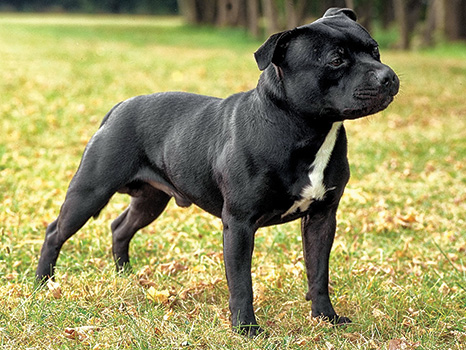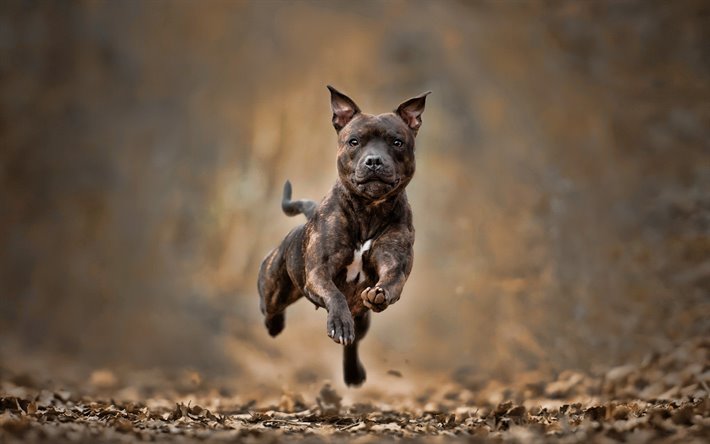The Staffordshire Bull Terrier is a British breed of short-haired terrier of medium size. It originated in the city of Birmingham and in the Black Country of Staffordshire from cross-breeding between the Bulldog and the English white terrier. It was bred as a fighting dog and, until blood sports were banned in 1835, was used for badger baiting, ratting, bull-baiting and dogfighting.
The Stafford is a descendant of the now-extinct bull and terrier cross, an ancestry developed in England in the early 19th century. The Bull Terrier, founded by James Hinks of Birmingham, England, the Stafford, the American Staffordshire Terrier and American Pit Bull Terrier all trace back to the bull-type terrier breeds with the common component being the Bulldog.
After the banning of blood sports and pit fighting in 1835, attitudes changed which, over the course of centuries, resulted in generations of responsible breeding and further breed refinement of the Stafford as a family pet and companion dog. The Stafford’s association in early 19th century as a fighting dog made it difficult for the breed to gain recognition by the Kennel Club in the United Kingdom but was eventually added to their purebred registry in 1935. Staffords first arrived in North America in the mid to late 1880s but it was not until 1974 that the American Kennel Club accepted the Staffordshire Bull Terrier into their purebred registry.
History
Early protection
The Cruelty to Animals Act 1835 made blood sports illegal, and effectively stopped bull and bear baiting in the UK. Bull and bear-baiting required large arenas which made it easier for authorities to police, whereas illegal dogfighting was much harder to terminate because fight sponsors kept their venues hidden and closely guarded in private basements and similar locations. As a result, dogfighting continued long after bull and bear-baiting had ceased. It was not until the passage of the Protection of Animals Act 1911 that organised dogfighting in Britain largely came to an end.
Early history
In the early 1800s, “bull and terrier” crossbreeds had been developed to satisfy the need for vermin control and the taste for blood sports. In the mid–19th century, James Hinks wanted to develop a socially acceptable “gentleman’s companion” with refinement, cleaner lines, and courage without aggressive tendencies. Two different types of bull and terriers resulted, including Hink’s cross of the bull and terrier with the English White Terrier to achieve a more refined appearance with better legs and a more appealing head. A later outcross included the Dalmatian and Collie which led to the development of an athletic white dog known as Hink’s “white cavalier”, the forerunner to the modern Bull Terrier. Devotees preferred the original bull and terrier type over Hink’s Bull Terrier and remained loyal to their preferred type, which became the modern Staffordshire Bull Terrier of the same ancestry as the Bull Terrier.
Theories of origin
The Stafford was developed in what was then considered the “black country” of Staffordshire and northern parts of Birmingham. There are two theories about the development of the Stafford as recognised by the KC registry.
The first and more widely held theory is that the Stafford, like the Bull Terrier, descends from the long-extinct bull and terrier, which originated as a cross between the ferocious, thickly muscled Old English Bulldog and the agile, lithe and feisty Black and Tan Terrier. The aggressive Old English Bulldog, bred for bear and bull-baiting, was often pitted against its own kind in organised dog fights, but it was determined that lighter, faster dogs were better suited for dogfighting than the heavier Bulldog. In an effort to produce a lighter, faster, more agile dog with the courage and tenacity of the Bulldog, breeders outcrossed with local terriers and ultimately achieved success.
The second less widely held theory is that the Old English Bulldog was not crossed with terriers; rather, the Stafford as a breed began with direct descendants derived from generations of selective breeding of early Bulldogs which produced a smaller dog with a more athletic build. Some believe the theory is evidentially supported by certain genetic characteristics and similarities in the appearances of modern Staffords when compared to the Old English Bulldogs depicted in some of the early 19th-century paintings.
DNA analysis
In 2017, a genome-wide study revealed that all of the bull and terrier type dogs, including the Staffordshire Bull Terrier, map back to the terriers of Ireland and to origins which date to the period 1860–1870. The timing coincides with historical descriptions of dog fighting contests in Ireland, a lack of accurate stud book documentation, and subsequently, the undocumented crosses of dogs during the time when these breeds were first created. By 1874, in Britain, the first Kennel Club Stud Book was published, which included Bull Terriers and Bulldogs.
Irish Staffordshire Bull Terrier
In the UK, American Pit Bull Terriers are sometimes advertised as Irish Staffordshire Bull Terriers in an attempt to circumvent the Dangerous Dogs Act 1991. The appearance of the Irish Staffordshire, which is not recognised by any kennel club or breed registry, is attributed by the RSPCA to be contributing “to a rise in incidents of dogfighting”. The editor of Dogs Today magazine described the breed as “complete fiction”.

